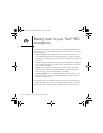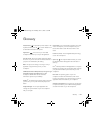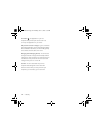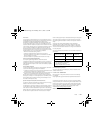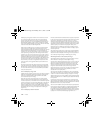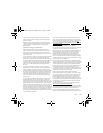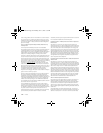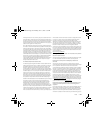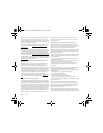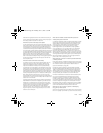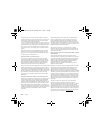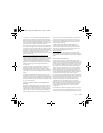196 :: FCC
Radiofrequency energy (RF) is another name for radio waves. It is one
form of electromagnetic energy that makes up the electromagnetic
spectrum. Some of the other forms of energy in the electromagnetic
spectrum are gamma rays, x-rays and light. Electromagnetic energy (or
electromagnetic radiation) consists of waves of electric and magnetic
energy moving together (radiating) through space. The area where these
waves are found is called an electromagnetic field.
Radio waves are created due to the movement of electrical charges in
antennas. As they are created, these waves radiate away from the
antenna. All electromagnetic waves travel at the speed of light. The major
differences between the different types of waves are the distances
covered by one cycle of the wave and the number of waves that pass a
certain point during a set time period. The wavelength is the distance
covered by one cycle of a wave. The frequency is the number of waves
passing a given point in one second. For any electromagnetic wave, the
wavelength multiplied by the frequency equals the speed of light. The
frequency of an RF signal is usually expressed in units called hertz (Hz).
One Hz equals one wave per second. One kilohertz (kHz) equals one
thousand waves per second, one megahertz (MHz) equals one million
waves per second, and one gigahertz (GHz) equals one billion waves
per second.
RF energy includes waves with frequencies ranging from about 3000
waves per second (3 kHz) to 300 billion waves per second (300 GHz).
Microwaves are a subset of radio waves that have frequencies ranging
from around 300 million waves per second (300 MHz) to three billion
waves per second (3 GHz).
How is radiofrequency energy used?
Probably the most important use of RF energy is for telecommunications.
Radio and TV broadcasting, wireless phones, pagers, cordless phones,
police and fire department radios, point-to-point links and satellite
communications all rely on RF energy.
Other uses of RF energy include microwave ovens, radar, industrial
heaters and sealers, and medical treatments. RF energy, especially at
microwave frequencies, can heat water. Since most food has a high water
content, microwaves can cook food quickly. Radar relies on RF energy to
track cars and airplanes as well as for military applications. Industrial
heaters and sealers use RF energy to mold plastic materials, glue wood
products, seal leather items such as shoes and pocketbooks, and process
food. Medical uses of RF energy include pacemaker monitoring and
programming.
How is radiofrequency radiation measured?
RF waves and RF fields have both electrical and magnetic components. It
is often convenient to express the strength of the RF field in terms of each
component. For example, the unit “volts per meter” (V/m) is used to
measure the electric field strength, and the unit “amperes per meter” (A/
m) is used to express the magnetic field strength. Another common way to
characterize an RF field is by means of the power density. Power density is
defined as power per unit area. For example, power density can be
expressed in terms of milliwatts (one thousandth of a watt) per square
centimeter (mW/cm2) or microwatts (one millionth of a watt) per square
centimeter (µW/cm2).
The quantity used to measure how much RF energy is actually absorbed
by the body is called the Specific Absorption Rate or SAR. The SAR is a
measure of the rate of absorption of RF energy. It is usually expressed in
units of watts per kilogram (W/kg) or milliwatts per gram (mW/g).
What biological effects can be caused by RF energy?
The biological effects of radiofrequency energy should not be confused
with the effects from other types of electromagnetic energy.
Very high levels of electromagnetic energy, such as is found in X-rays and
gamma rays, can ionize biological tissues. Ionization is a process where
electrons are stripped away from their normal locations in atoms and
molecules. It can permanently damage biological tissues including DNA,
the genetic material. Ionization only occurs with very high levels of
electromagnetic energy such as X-rays and gamma rays. Often the term
radiation is used when discussing ionizing radiation (such as that
associated with nuclear power plants).
The energy levels associated with radiofrequency energy, including both
radio waves and microwaves, are not great enough to cause the ionization
of atoms and molecules. Therefore, RF energy is a type of non-ionizing
radiation. Other types of non-ionizing radiation include visible light, infrared
radiation (heat) and other forms of electromagnetic radiation with relatively
low frequencies.
Large amounts of RF energy can heat tissue. This can damage tissues
and increase body temperatures. Two areas of the body, the eyes and the
testes, are particularly vulnerable to RF heating because there is relatively
little blood flow in them to carry away excess heat.
The amount of RF radiation routinely encountered by the general public is
too low to produce significant heating or increased body temperature. Still,
some people have questions about the possible health effects of low
levels of RF energy. It is generally agreed that further research is needed
to determine what effects actually occur and whether they are dangerous
to people. In the meantime, standards-setting organizations and
RushUG.book Page 196 Monday, June 13, 2005 1:33 PM





